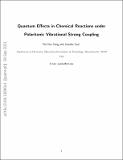Notice
This is not the latest version of this item. The latest version can be found at:https://dspace.mit.edu/handle/1721.1/141048.2
Quantum Effects in Chemical Reactions under Polaritonic Vibrational Strong Coupling
Author(s)
Yang, Pei-Yun; Cao, Jianshu
DownloadAccepted version (2.698Mb)
Open Access Policy
Open Access Policy
Creative Commons Attribution-Noncommercial-Share Alike
Terms of use
Metadata
Show full item recordAbstract
The electromagnetic field in an optical cavity can dramatically modify and even control chemical reactivity via vibrational strong coupling (VSC). Since the typical vibration and cavity frequencies are considerably larger than thermal energy, it is essential to adopt a quantum description of cavity-catalyzed adiabatic chemical reactions. Using quantum transition state theory (TST), we examine the coherent nature of adiabatic reactions in cavities and derive the cavity-induced changes in eigenfrequencies, zero-point energy, and quantum tunneling. The resulting quantum TST calculation allows us to explain and predict the resonance effect (i.e., maximal kinetic modification via tuning the cavity frequency), collective effect (i.e., linear scaling with the molecular density), and selectivity (i.e., cavity-induced control of the branching ratio). The TST calculation is further supported by perturbative analysis of polariton normal modes, which not only provides physical insights to cavity-catalyzed chemical reactions but also presents a general approach to treat other VSC phenomena.
Date issued
2021Journal
Journal of Physical Chemistry Letters
Publisher
American Chemical Society (ACS)
Citation
Yang, Pei-Yun and Cao, Jianshu. 2021. "Quantum Effects in Chemical Reactions under Polaritonic Vibrational Strong Coupling." Journal of Physical Chemistry Letters, 12 (39).
Version: Author's final manuscript